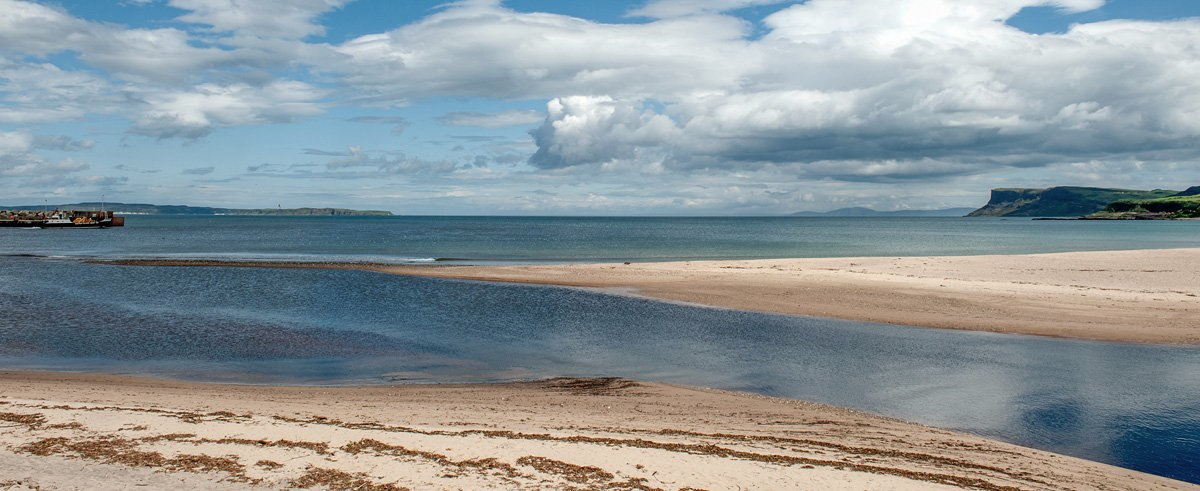The castle which gives the town its name was built in circa 1609 by the Earl of Antrim and was located where the Holy Trinity Church is in the Diamond, a few stones are all that remain. An older castle stood on the cliffs overlooking the ferry terminal, known as Dunineeny or Dunaneanie, it was where Sorley Boy MacDonnell was born in 1505 and died in 1590. Ballycastle developed from a strategic landing stage at the mouth of the river Margie and became known as Margietown, there are references to it as Market Town and Port Brittas. From here Fergus (son of Erc, King of Dalriada) set out with his brothers Angus and Loarn in circa 502AD to expand Dalriada into the land of the Picts, after their success, Dalriada Kingdom stretched from Bushmills to Larne and included Argyll and Bute.
Fergus and his people are associated with the Scotti, people who gave their name to Scotland, Fergus took Stone of Destiny ( Lia Fiall), on which the Irish kings were crowned, to Dunadd in Argyll and Bute and became the first Irish king to rule from Scotland. The same 'Stone of Destiny' used in Westminster Abbey by English monarchs was returned to Scotland in 1996. Patricius (St Patrick) founded Rathmudhain (Ramoan) in the 5th century, the old graveyard exists on the original site but the ruins are of a later building. He also founded a church at Carey, Culfeightrim, Drumeeny, Glenshesk and the monastic settlement of Armoy. Two followers associated with the area would become saints in their own right, Gobban and Olcan (Armoy). Gobban the builder is reputed to have built several churches including Templastragh (Temple of the Flame) at Portbraddon.
The development of Ballycastle took off in the 16th century under the influence of Col. Hugh Boyd who invested in its natural resources, he opened coal mines, tan yards, a brewery, salt works and a glass works which produced bottles, window and plate glass. A harbour was built in 1748 where the tennis courts are today. After four years Boyd petitioned the government for funds to repair it after the piles were attacked by insects. Eventually, he was reimbursed for replacing the damaged piles with cut stone. He was an exceptional landlord and employer who during the famine period when other wealthy landlords fled the country, he imported corn, oatmeal and flour to combat starvation. He died in 1765 and is interred in Holy Trinity Church which he built-in 1756.
The area of North Antrim is associated with many myths and legends of Ireland due in part to it being one of the first human settlements in Ireland. 'The Lamentable Fate of the Sons of Uishneach' tells the story of Deidre fleeing with the sons of Uishneach from Conovar, the King of Ulster wanted to marry her against her will, she came ashore on a causeway of basalt known as Carrig-Uishneach between at thec far end of Ballycastle beach now known as the Pans Rocks. Another famous legend, 'The Children of Lir', recounts the the story of four children of King Lir being turned into swans by their stepmother and exiled. They spent 900 years roaming three different parts of Ireland, one of these was the 'Cold Seas of Moyle'. Local folklore tells us they sheltered from winter storms in the mouth of the river Margie.
Another famous link came in 1898 when George Kemp, an assistant of Guglielmo Marconi, carried out 'wireless telegraph' transmissions between Rathlin Island and Ballycastle. The work was commissioned by Lloyds of London who were keen to employ this new technology in tracking trans-Atlantic shipping for insurance purposes. The History of Ballycastle makes fascinating reading, there is a link from the menu to an excellent synopsis written by the late Hugh A. Boyd of Ballycastle, a well respected local historian which is well worth reading.





